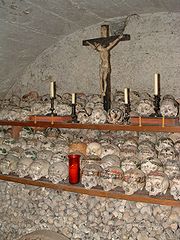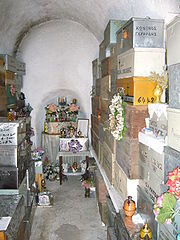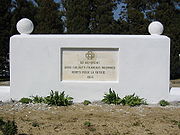
Ossuary
Encyclopedia

Skeleton
The skeleton is the body part that forms the supporting structure of an organism. There are two different skeletal types: the exoskeleton, which is the stable outer shell of an organism, and the endoskeleton, which forms the support structure inside the body.In a figurative sense, skeleton can...
remains. They are frequently used where burial space is scarce. A body is first buried in a temporary grave, then after some years the skeletal remains are removed and placed in an ossuary. The greatly reduced space taken up by an ossuary means that it is possible to store the remains of many more people in a single tomb than if the original coffins were left as is.
Persian
In Persia, the Zoroastrians used a deep well for this function from the earliest times (circa 3,000 years ago) and called it astudan (literally, "the place for the bones"). There are many rituals and regulations in the Zoroastrian faith concerning the astudans. Among the pre-7th-century SogdiansSogdiana
Sogdiana or Sogdia was the ancient civilization of an Iranian people and a province of the Achaemenid Empire, eighteenth in the list on the Behistun Inscription of Darius the Great . Sogdiana is "listed" as the second of the "good lands and countries" that Ahura Mazda created...
in the region of central Asia, the name for an ossuary was tanbar.
Roman Catholic
Many examples of ossuaries are found within Europe such as the Santa Maria della Concezione dei CappucciniSanta Maria della Concezione dei Cappuccini
Santa Maria della Concezione dei Cappuccini, or Our Lady of the Conception of the Capuchins, is a church in Rome, Italy, commissioned by Pope Urban VIII, whose brother, Antonio Barberini, was a Capuchin friar...
in Rome
Rome
Rome is the capital of Italy and the country's largest and most populated city and comune, with over 2.7 million residents in . The city is located in the central-western portion of the Italian Peninsula, on the Tiber River within the Lazio region of Italy.Rome's history spans two and a half...
, Italy
Italy
Italy , officially the Italian Republic languages]] under the European Charter for Regional or Minority Languages. In each of these, Italy's official name is as follows:;;;;;;;;), is a unitary parliamentary republic in South-Central Europe. To the north it borders France, Switzerland, Austria and...
, the San Bernardino alle Ossa
San Bernardino alle Ossa
San Bernardino alle Ossa is a church in Milan, northern Italy, best known for its ossuary, a small side chapel decorated with numerous human skulls and bones....
in Milan
Milan
Milan is the second-largest city in Italy and the capital city of the region of Lombardy and of the province of Milan. The city proper has a population of about 1.3 million, while its urban area, roughly coinciding with its administrative province and the bordering Province of Monza and Brianza ,...
, Italy, the Sedlec Ossuary
Sedlec Ossuary
The Sedlec Ossuary is a small Roman Catholic chapel, located beneath the Cemetery Church of All Saints in Sedlec, a suburb of Kutná Hora in the Czech Republic...
in the Czech Republic
Czech Republic
The Czech Republic is a landlocked country in Central Europe. The country is bordered by Poland to the northeast, Slovakia to the east, Austria to the south, and Germany to the west and northwest....
, the Skull Chapel in Czermna
Skull Chapel in Czermna
Skull Chapel in Czermna is a chapel situated in Kudowa-Zdrój, Lower Silesian Voivodeship, Poland. This unusual chapel was built in 1776 by the local parish priest Wacław Tomaszek. It is the mass grave of people who died during the Thirty Years’ War , three Silesian Wars , as well as of people who...
in Lower Silesia, Poland, and Capela dos Ossos
Capela dos Ossos
The Capela dos Ossos is one of the best known monuments in Évora, Portugal. It is a small interior chapel located next to the entrance of the Church of St. Francis...
(Chapel of bones) in the city of Évora
Évora
Évora is a municipality in Portugal. It has total area of with a population of 55,619 inhabitants. It is the seat of the Évora District and capital of the Alentejo region. The municipality is composed of 19 civil parishes, and is located in Évora District....
, in Portugal
Portugal
Portugal , officially the Portuguese Republic is a country situated in southwestern Europe on the Iberian Peninsula. Portugal is the westernmost country of Europe, and is bordered by the Atlantic Ocean to the West and South and by Spain to the North and East. The Atlantic archipelagos of the...
. The village of Wamba in the province of Valladolid
Valladolid
Valladolid is a historic city and municipality in north-central Spain, situated at the confluence of the Pisuerga and Esgueva rivers, and located within three wine-making regions: Ribera del Duero, Rueda and Cigales...
, Spain
Spain
Spain , officially the Kingdom of Spain languages]] under the European Charter for Regional or Minority Languages. In each of these, Spain's official name is as follows:;;;;;;), is a country and member state of the European Union located in southwestern Europe on the Iberian Peninsula...
has an impressive ossuary of over a thousand skulls inside the local church, dating from between the 12th and the 18th centuries. A more recent example is the Douaumont ossuary
Douaumont ossuary
The Douaumont ossuary is a memorial containing the remains of soldiers who died on the battlefield during the Battle of Verdun in World War I. It is located in Douaumont, France, within the Verdun battlefield.-History:...
in France
France
The French Republic , The French Republic , The French Republic , (commonly known as France , is a unitary semi-presidential republic in Western Europe with several overseas territories and islands located on other continents and in the Indian, Pacific, and Atlantic oceans. Metropolitan France...
that contains the remains of more than 130,000 French and German soldiers that fell at the Battle of Verdun
Battle of Verdun
The Battle of Verdun was one of the major battles during the First World War on the Western Front. It was fought between the German and French armies, from 21 February – 18 December 1916, on hilly terrain north of the city of Verdun-sur-Meuse in north-eastern France...
during World War I
World War I
World War I , which was predominantly called the World War or the Great War from its occurrence until 1939, and the First World War or World War I thereafter, was a major war centred in Europe that began on 28 July 1914 and lasted until 11 November 1918...
.
The catacombs
Catacombs
Catacombs, human-made subterranean passageways for religious practice. Any chamber used as a burial place can be described as a catacomb, although the word is most commonly associated with the Roman empire...
beneath the Monastery of San Francisco in Lima
Lima
Lima is the capital and the largest city of Peru. It is located in the valleys of the Chillón, Rímac and Lurín rivers, in the central part of the country, on a desert coast overlooking the Pacific Ocean. Together with the seaport of Callao, it forms a contiguous urban area known as the Lima...
, Peru
Peru
Peru , officially the Republic of Peru , is a country in western South America. It is bordered on the north by Ecuador and Colombia, on the east by Brazil, on the southeast by Bolivia, on the south by Chile, and on the west by the Pacific Ocean....
also contain an ossuary.
Eastern Orthodox

Sanctification
Sanctity is an ancient concept widespread among religions, a property of a thing or person sacred or set apart within the religion, from totem poles through temple vessels to days of the week, to a human believer who achieves this state. Sanctification is the act or process of acquiring sanctity,...
and transfigured by Baptism
Baptism
In Christianity, baptism is for the majority the rite of admission , almost invariably with the use of water, into the Christian Church generally and also membership of a particular church tradition...
, Holy Communion and the participation in the mystical life
Sacred Mysteries
The term sacred mysteries generally denotes the area of supernatural phenomena associated with a divinity or a religious ideology.-Pre-Christian religious mysteries:...
of the Church. In Orthodox monasteries
Monastery
Monastery denotes the building, or complex of buildings, that houses a room reserved for prayer as well as the domestic quarters and workplace of monastics, whether monks or nuns, and whether living in community or alone .Monasteries may vary greatly in size – a small dwelling accommodating only...
, when one of the brethren dies, his remains are buried (for details, see Christian burial
Christian burial
A Christian burial is the burial of a deceased person with specifically Christian ecclesiastical rites; typically, in consecrated ground. Until recent times Christians generally objected to cremation, and practised inhumation almost exclusively, but this opposition has weakened, and now vanished...
) for one to three years, and then disinterred, cleaned and gathered into the monastery's charnel house
Charnel house
A charnel house is a vault or building where human skeletal remains are stored. They are often built near churches for depositing bones that are unearthed while digging graves...
. If there is reason to believe that the departed is a saint
Saint
A saint is a holy person. In various religions, saints are people who are believed to have exceptional holiness.In Christian usage, "saint" refers to any believer who is "in Christ", and in whom Christ dwells, whether in heaven or in earth...
, the remains may be placed in a reliquary
Reliquary
A reliquary is a container for relics. These may be the physical remains of saints, such as bones, pieces of clothing, or some object associated with saints or other religious figures...
; otherwise the bones are usually mingled together (skulls together in one place, long bone
Long bone
The long bones are those that are longer than they are wide. They are one of five types of bones: long, short, flat, irregular and sesamoid. Long bones, especially the femur and tibia, are subjected to most of the load during daily activities and they are crucial for skeletal mobility. They grow...
s in another, etc.). The remains of an abbot
Abbot
The word abbot, meaning father, is a title given to the head of a monastery in various traditions, including Christianity. The office may also be given as an honorary title to a clergyman who is not actually the head of a monastery...
may be placed in a separate ossuary made out of wood or metal.
The use of ossuaries is also found among the laity
Laity
In religious organizations, the laity comprises all people who are not in the clergy. A person who is a member of a religious order who is not ordained legitimate clergy is considered as a member of the laity, even though they are members of a religious order .In the past in Christian cultures, the...
in the Greek Orthodox Church
Greek Orthodox Church
The Greek Orthodox Church is the body of several churches within the larger communion of Eastern Orthodox Christianity sharing a common cultural tradition whose liturgy is also traditionally conducted in Koine Greek, the original language of the New Testament...
. The departed will be buried for one to three years and then, often on the anniversary of death, the family will gather with the parish priest and celebrate a parastas (memorial service), after which the remains are disinterred, washed with wine, perfumed, and placed in a small ossuary of wood or metal, inscribed with the name of the departed, and placed in a room, often in or near the church, which is dedicated to this purpose.
Jewish

Second Temple
The Jewish Second Temple was an important shrine which stood on the Temple Mount in Jerusalem between 516 BCE and 70 CE. It replaced the First Temple which was destroyed in 586 BCE, when the Jewish nation was exiled to Babylon...
, Jewish
Jews
The Jews , also known as the Jewish people, are a nation and ethnoreligious group originating in the Israelites or Hebrews of the Ancient Near East. The Jewish ethnicity, nationality, and religion are strongly interrelated, as Judaism is the traditional faith of the Jewish nation...
burial customs included primary burials in burial caves, followed by secondary burials in ossuaries placed in smaller niches of the burial caves. Some of the limestone ossuaries that have been discovered, particularly around the Jerusalem area, include intricate geometrical patterns and inscriptions identifying the deceased. Among the best-known Jewish ossuaries of this period are: an ossuary inscribed 'Simon the Temple builder' in the collection of the Israel Museum
Israel Museum
The Israel Museum, Jerusalem was founded in 1965 as Israel's national museum. It is situated on a hill in the Givat Ram neighborhood of Jerusalem, near the Bible Lands Museum, the Knesset, the Israeli Supreme Court, and the Hebrew University of Jerusalem....
, another incribed 'Elisheba wife of Tarfon
Tarfon
Rabbi Tarfon or Tarphon, , a Kohen, a member of the third generation of the Mishnah sages, who lived in the period between the destruction of the Second Temple and the fall of Bethar .-Origins and character:...
', one inscribed 'Yehohanan ben Hagkol' that contained an iron nail in a heel bone suggesting crucifixion
Crucifixion
Crucifixion is an ancient method of painful execution in which the condemned person is tied or nailed to a large wooden cross and left to hang until dead...
, another inscribed 'James
James Ossuary
The James Ossuary is a 2,000-year old chalk box that was used for containing the bones of the dead. The Aramaic inscription: Ya'akov bar-Yosef akhui diYeshua is cut into one side of the box...
son of Joseph, brother of Jesus', the authenticity of which is suspect, and ten ossuaries recovered from the Talpiot Tomb
Talpiot Tomb
The Talpiot Tomb is a rock-cut tomb discovered in 1980 in the East Talpiot neighborhood, five kilometers south of the Old City in East Jerusalem. It contained ten ossuaries, six of them with epigraphs, including one with the inscription that has been interpreted as "Jesus, son of Joseph", though...
in 1980, several of which are reported to have names from the New Testament
New Testament
The New Testament is the second major division of the Christian biblical canon, the first such division being the much longer Old Testament....
.
During the Second Temple period, Jewish sages debated whether the occasion of the gathering of a parent's bones for a secondary burial was a day of sorrow or rejoicing; it was resolved that it was a day of fasting in the morning and feasting in the afternoon. The custom of secondary burial in ossuaries did not persist among Jews past the Second Temple period nor appear to exist among Jews outside the land of Israel
Israel
The State of Israel is a parliamentary republic located in the Middle East, along the eastern shore of the Mediterranean Sea...
.

See also
- Catacomb
- Charnel houseCharnel houseA charnel house is a vault or building where human skeletal remains are stored. They are often built near churches for depositing bones that are unearthed while digging graves...
- CryptCryptIn architecture, a crypt is a stone chamber or vault beneath the floor of a burial vault possibly containing sarcophagi, coffins or relics....
- GraveGrave (burial)A grave is a location where a dead body is buried. Graves are usually located in special areas set aside for the purpose of burial, such as graveyards or cemeteries....
- MausoleumMausoleumA mausoleum is an external free-standing building constructed as a monument enclosing the interment space or burial chamber of a deceased person or persons. A monument without the interment is a cenotaph. A mausoleum may be considered a type of tomb or the tomb may be considered to be within the...
- ReliquaryReliquaryA reliquary is a container for relics. These may be the physical remains of saints, such as bones, pieces of clothing, or some object associated with saints or other religious figures...
- TombTombA tomb is a repository for the remains of the dead. It is generally any structurally enclosed interment space or burial chamber, of varying sizes...
- James OssuaryJames OssuaryThe James Ossuary is a 2,000-year old chalk box that was used for containing the bones of the dead. The Aramaic inscription: Ya'akov bar-Yosef akhui diYeshua is cut into one side of the box...
- ColumbariumColumbariumA columbarium is a place for the respectful and usually public storage of cinerary urns . The term comes from the Latin columba and originally referred to compartmentalized housing for doves and pigeons .The Columbarium of Pomponius Hylas is a particularly fine ancient Roman example, rich in...

